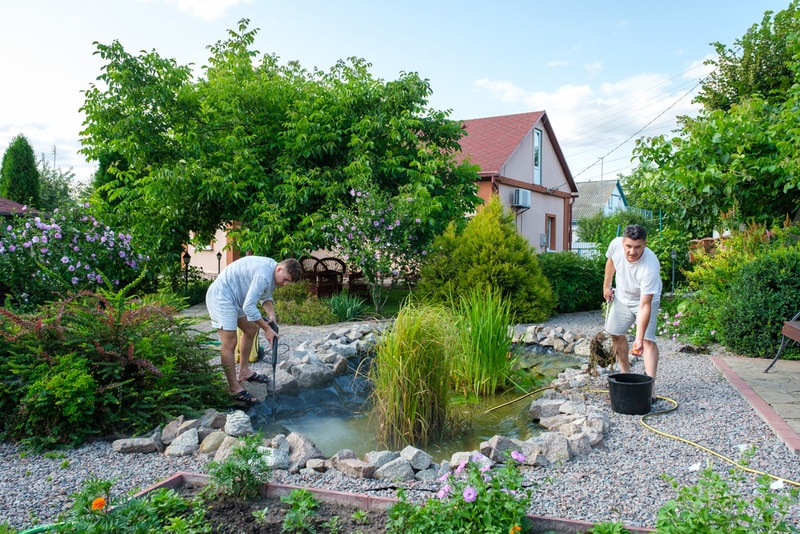Maintaining a goldfish pond is both relaxing and rewarding, and part of the maintenance includes preparing your goldfish for winter. This is usually necessary if the winters become too cold for goldfish to tolerate and are out of their ideal temperature range.
In some cases, the pond could be at risk of freezing over. Unless you plan to “overwinter” your goldfish indoors, it’s a good idea to prepare both the pond and goldfish for the expected frigid conditions. Preparing your goldfish pond for winter is essential and ensures that your goldfish are kept healthy during the cold winter months.
This article will give you all the information you need to start preparing your goldfish pond for winter and which supplies will benefit you during this time.

The 3 Reasons You Should Prepare Your Goldfish Pond for Winter
When it comes to raising pond goldfish, you generally have two options to ensure their survival during freezing winters. This includes either overwintering your goldfish indoors or preparing them and the pond for cold conditions in the pond. If you choose the latter, below are three noteworthy benefits that we will discuss.
1. Allows your goldfish to survive in freezing temperatures.
One of the main reasons you may keep your goldfish in a pond is because of their ability to thrive outdoors unlike many other aquarium fish. Although goldfish are considered to be hardy and adaptable fish, they still cannot survive in unfavorable conditions for a long time. However, you still need to prepare your goldfish for the winter to ensure that they will be able to survive the colder months. The colder temperatures may make your goldfish more susceptible to disease and slow down their metabolism.
Certain varieties of goldfish are hardier than others, but that doesn’t mean that they will survive for very long in frozen ponds. Without the proper preparation, many goldfish can die from being too cold. While many varieties of goldfish can tolerate temperatures as low as 50 degrees Fahrenheit, it isn’t good to expose them to these conditions for more than a few days.
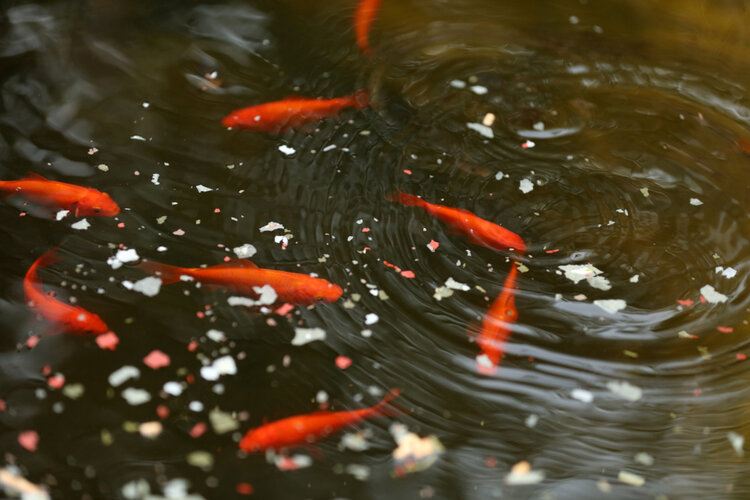
2. Prepares the pond and plants for winter.
Aside from the goldfish, you also need to ensure that the pond will be able to withstand the cold temperatures. Some of your pond equipment might not function properly below a certain temperature or get damaged from rain, snow, or general freezing conditions. If this is the case, then you will need to take the appropriate measures to protect the equipment from the elements and allow it to function properly in cold temperatures.
Alternatively, the pond plants may also suffer during winter time. This makes it necessary to keep the pond within the ideal conditions that allow the plants to carry on growing, or take them indoors.
3. Prolongs the lifespan of the pond.
Even the most well-built pond can get damaged during the winter months. If you want to prolong the lifespan of the pond and keep it in good condition, you will need to keep it protected from harsh weather elements. Preparing the pond for winter can keep it clean and secure from potential damage, leaks, or flooding. This will also ensure that the pond is safe enough to house the goldfish until the weather warms up.


The 5 Essential Supplies You May Need
Before you start preparing the pond for the cold winter months, you may need the following essential supplies.
1. A Pond Heater
If you don’t plan to overwinter your goldfish indoors where the temperature is slightly warmer, you may need to use a pond heater, otherwise known as a de-icer. This will help prevent the pond from freezing over and keep the pond water warm and comfortable for the goldfish. A pond heater is only necessary if the water temperature drops below 50 degrees Fahrenheit for an extended time. Make sure that you buy a pond heater with a suitable wattage for the size of your pond.
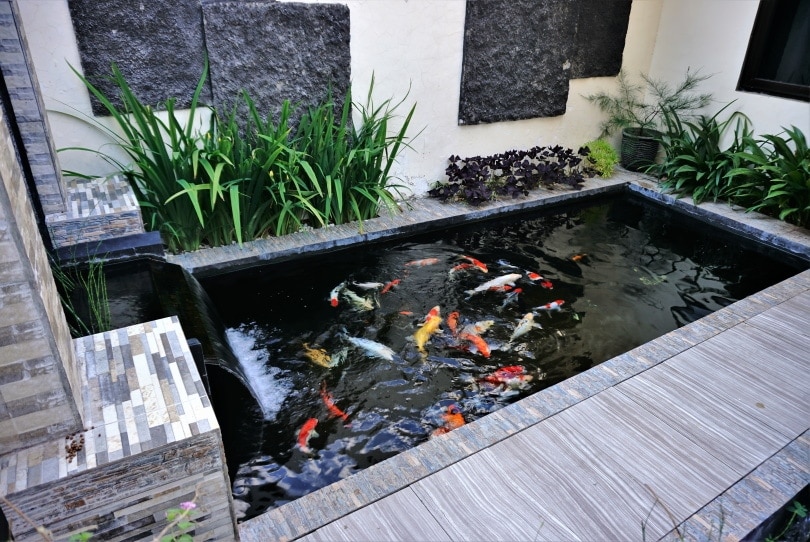
2. Tubs or Extra Tanks
It’s always a good idea to have large tubs or extra tanks on hand in case you need to overwinter your goldfish indoors. This is necessary for fancy goldfish or situations where the goldfish aren’t handling the cold well. Fancy goldfish aren’t as tolerant of cold temperatures as a Comet or some common goldfish varieties. You may find that the extra tubs and tanks are useful for treating any goldfish that have developed a disease or injury during the winter and need to be treated separately from the other goldfish.
3. A Filtration System
While the main pond should already be equipped with a filtration system, you might need to buy a spare one for the indoor tubs and tanks. A large sponge filter may work best since these types of filters can be used even if the tank is being treated with medication. They also produce bubbles which can help oxygenate the water.

4. Pond Shelter
Heavy rains and snowing can be bad for your goldfish pond, leading to flooding and frozen water. Setting up a shelter or covering it over the pond can protect it from these elements and keep both your goldfish and the pond protected. This shelter can also help keep the pond insulated if you are running a pond heater. Furthermore, a shelter over the pond can help prevent leaves and debris from falling into the pond.
The pond shelter can either be built over the pond, or you can secure a tarp over it. However, you should leave a few inches of space between the shelter and the pond for appropriate airflow. The pond shelter may also help protect any pond equipment you are running from rain and snow.
5. An Aeration System
If the pond’s filtration system doesn’t provide sufficient surface agitation, it might be worth looking into adding an aeration system. This could be a bubbler for a pond or a water feature that causes surface agitation. When used alongside a pond heater, you will be able to prevent the pond from freezing over and provide the goldfish with oxygen.


The 6 Steps on How to Prepare Your Goldfish Pond for Winter
Step 1: Clean the Pond
Start by cleaning up the pond a few weeks before winter. This will prevent any leaves, sticks, and debris from rotting in the pond during winter when it is difficult to clean. By cleaning the pond, you will also keep the water in good condition if any pond equipment needs to be turned off. Do a deep clean by scooping out debris and cleaning the filter and pond skimmer.
Step 2: Check That the Pond Equipment Is Working
The pond equipment should be checked for any issues and general wear and tear. Any faulty pond equipment should be replaced to ensure that it will be working for the winter months. This includes checking that the filter is running normally and that the pump motor is not damaged. If you have a pond skimmer, check that the basket has been cleaned and that water is passing through it properly.

Step 3: Prepare the Goldfish
One of the most important steps is to prepare the goldfish for the colder temperatures they will be experiencing. Start by adjusting their diet a few weeks before the cold temperatures set in. You should still stick to their regular diet and feeding schedule, but gradually introduce protein and carbohydrate-rich foods into their diet. This includes foods like bloodworms or shrimp, blanched veggies like zucchini, and a high-quality pellet mix.
A goldfish’s metabolism may slow down in colder temperatures below 50 degrees Fahrenheit and they may start refusing food. You might need to stop feeding them if the temperature drops too low. This is because any leftover food that the goldfish don’t eat can start fouling the water, causing water quality issues.
If your pond is stocked with fancy goldfish, it is better to take them indoors. You will need to set up a tub or large tank for these goldfish and add in a sponge filter. They can be placed back into the pond when the temperature is right again.
Step 4: Prepare the Pond Plants
Unless you have hardy and adaptable pond plants that can survive in freezing temperatures, you should take them indoors. In some cases, certain annual pond plants will naturally lose their leaves over winter and regrow them again. It is important to ensure that the pond plants have been properly planted into the pond and that any dead and decaying leaves are removed. Depending on the type of pond plant, you may need to trim them in preparation for colder temperatures.
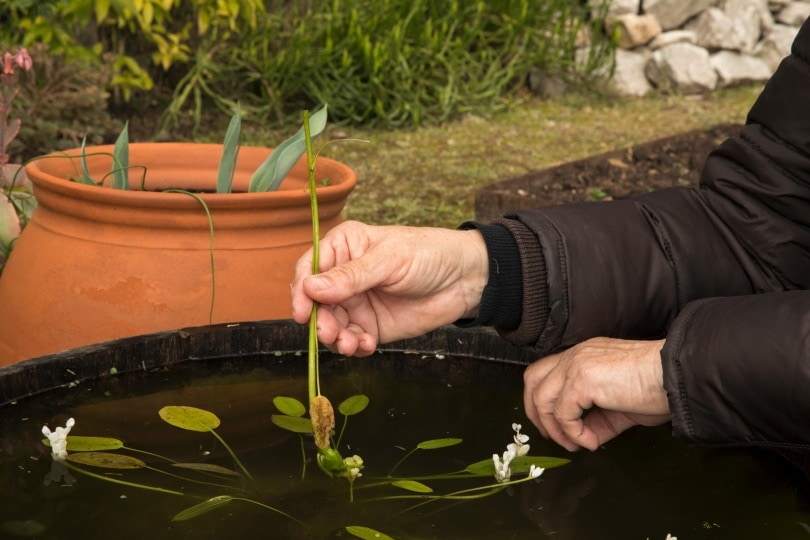
Step 5: Protect the Pond and Equipment
Protecting the pond equipment like wiring, electrical boxes, and filters is essential. Freezing conditions may affect how well the pond equipment functions or prevent it from functioning at all. Extreme weather conditions like snow can affect the pond’s electrical supply and put the wiring at risk of snapping. Furthermore, any frozen pipes can also burst from the pressure.
This can make it difficult to run the pond and keep the water safe for your goldfish to live in. In some instances, it might be best to drain the pond and remove the pond equipment entirely. It can be difficult to protect your goldfish pond and equipment from heavy snow, and it is much safer to bring everything inside where it can be protected.
Adding a shelter over the pond can help protect the equipment and may prevent them from getting damaged.
Step 6: Add a pond heater and aeration system
As soon as the pond is experiencing cold temperatures, it is time to add the heater and aeration system. This step is necessary if the pond is likely to freeze over, which can be harmful to your goldfish. A pond heater can also prevent any harmful gasses from getting trapped under the ice since it leaves a gap for gaseous exchange. When adding a pond heater, you should add a thermometer to monitor the temperature.
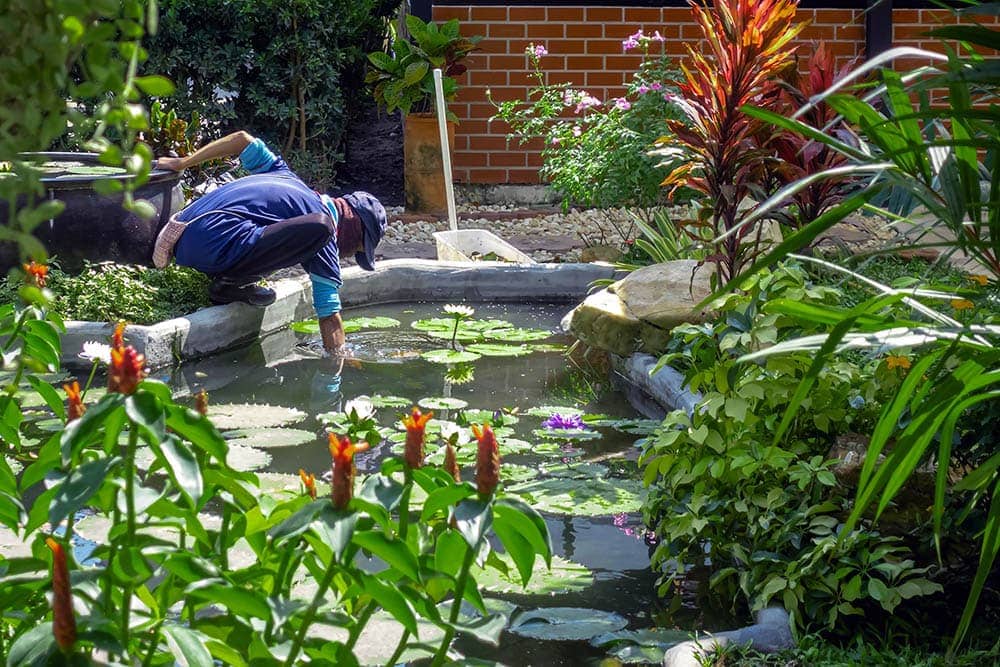

Conclusion
Preparing a goldfish pond for winter is a crucial part of maintaining a pond. It involves cleaning the pond, altering your goldfish diet, and checking that the pond equipment is in working order. Also, you will need to avoid overfeeding your goldfish in winter, since the colder temperatures may affect the way they digest their food.
Looking for more fish pond tips? Try:
- 10 Best Fish Safe Pond Algaecides and Algae Killers
- How to Get Rid of Duckweed in a Pond (Without Harming Fish)
Featured Image Credit: serhii.suravikin, Shutterstock
